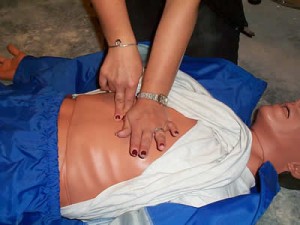Mouth-to-mouth resuscitation has always been the focal point of CPR classes. However, medical experts have revamped the process and placed more emphasis on chest compressions, which they believed gives cardiac arrest victims a better chance at survival, and also makes CPR administered by ordinary people more effective.
CPR used to be performed by following the acronym “ABC”, which stood for airway, breathing and circulation. But CPR courses now teach people to follow CAB – circulation, airway and breathing. The new method was introduced in 2010 by the American Heart Association and puts the focus on chest compressions.

This method, which is also known as hands-only CPR, basically turns the rescuer into the victim’s heart and helps keep oxygenated blood pumping to the key organs of the patient’s body. The steps of doing hands-only CPR are simple and easy to grasp –
• Kneel close to the patient’s neck and shoulders, position the heel of your hands one on top of the other and place them in the middle of the patient’s chest. Simply put, place your hands in the middle of the two nipples. Make sure your elbows are straight and that your shoulders are positioned over your hands.
• Use the weight of your upper body to push the chest down. This would give you more force than if you’re just going to use your arms. Try to compress the chest by 1” – 2”.
• Press down hard and try to finish around 100 compressions a minute. Medical responders use the Bee Gees classic Stayin’ Alive to keep the right speed and pace of their chest compressions. The song is known for its 103 catchy beats per minutes and is easy recall, making it perfect for CPR.
• CPR for adults and babies are different. For babies, two fingers are used for chest compressions rather than the two hands. Rescuers should also remember to be gentler with their compressions, keeping it at 1.5” but still completing around 100 compressions a minute.
The idea behind chest compressions is to place pressure on the chest so that oxygenated blood is forced out of the heart through the aorta which then moves to the brain and other vital organs, ensuring that there’s cellular respiration and keeping them viable.
While the steps to doing chest compressions are remarkably easy to understand and follow, the sad reality is that people’s initial reactions when someone has a cardiac arrest is to panic and be confused; and in those key moments a person’s life hangs in the balance. This is why there are numerous St Mark James programs that are being pushed to help teach or hone people’s CPR skills. It’s a valuable life skill that everyone should know and there are various institutions that can help teach people about it.
Related Vods:

